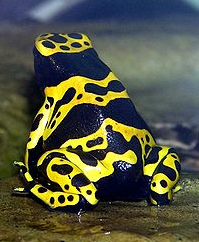
List Of Frogs And Toads In The UK
Most species of poison dart frogs are small, sometimes less than 1.5 cm (0.59 in) in adult length, although a few grow up to 6 cm (2.4 in) in length. They weigh 1 oz.on average.[4] Most poison dart frogs are brightly colored, displaying aposematic patterns to warn potential predators. Their bright coloration is associated with their toxicity and levels of alkaloids. Frogs such as theDendrobates genus have high levels of alkaloids, whereas the Colostethus species are cryptically colored and are not toxic.[5]
Poison dart frogs are an example of an aposematic organism. Their bright coloration advertises unpalatability to potential predators. Aposematism is currently thought to have originated at least four times within the poison dart family according to phylogenetic trees, and dendrobatid frogs have since undergone dramatic divergences – both interspecific and intraspecific – in their aposematic coloration. This is surprising given the frequency-dependent nature of this type of defense mechanism.[6][7]
Adult frogs lay their eggs in moist places, including on leaves, in plants, among exposed roots, and elsewhere. Once the eggs hatch, the adult piggybacks thetadpoles, one at a time, to suitable water, either a pool, or the water gathered in the throat of bromeliads or other plants. The tadpoles remain there until theymetamorphose, fed by unfertilised eggs laid at regular intervals by the mother.[8]
Habitat Poison dart frogs are endemic to humid, tropical environments of Central and South America.[2] These frogs are generally found in tropical rainforests, including in Bolivia,Costa Rica, Brazil, Colombia, Ecuador, Venezuela, Suriname, French Guiana, Peru,Panama, Guyana, Nicaragua, and Hawaii (introduced).[2][9][]
Natural habitats include subtropical and tropical, moist, lowland forests, subtropical or tropical high-altitude shrubland, subtropical or tropical, moist, montanes and rivers, freshwater marshes, intermittent freshwater marshes, lakes and swamps. Other species can be found in seasonally wet or flooded lowland grassland, arable land, pastureland, rural gardens, plantations, moist savanna and heavily degraded former forest. Premontane forests and rocky areas have also been known to hold frogs. Dendrobatids tend to live on or close to the ground, but also in trees as much as 10 m (33 ft) from the ground.[10][]
[]
All items (23)





















